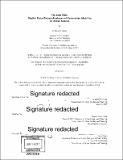| dc.contributor.advisor | Dennis Frenchman. | en_US |
| dc.contributor.author | Vanky, Anthony P. (Anthony Phong) | en_US |
| dc.contributor.other | Massachusetts Institute of Technology. Department of Urban Studies and Planning. | en_US |
| dc.date.accessioned | 2017-09-15T15:31:16Z | |
| dc.date.available | 2017-09-15T15:31:16Z | |
| dc.date.copyright | 2017 | en_US |
| dc.date.issued | 2017 | en_US |
| dc.identifier.uri | http://hdl.handle.net/1721.1/111372 | |
| dc.description | Thesis: Ph. D., Massachusetts Institute of Technology, Department of Urban Studies and Planning, 2017. | en_US |
| dc.description | Page 157 blank. Cataloged from PDF version of thesis. | en_US |
| dc.description | Includes bibliographical references (pages 135-156). | en_US |
| dc.description.abstract | Understanding how environmental attributes can influence the behavior of pedestrians is of concern for public health officials, transportation engineers, and urban planners. To what degree, if any, do these various environmental characteristics influence how much and for how long people walk? To answer these questions, this thesis analyzes large-scale spatiotemporal pedestrian activity records collected from the users of a mobile phone application in Greater Boston, Massachusetts and the San Francisco Bay Area, California. The dataset contains the locative traces of recreational and utilitarian pedestrian walking activities which include the GPS and temporal records of individuals. In sum, this dissertation considered over 2.2 million trips from 135,000 people. This thesis addresses the topic in three parts. The first study examines the impacts of climate and environment on active transportation trips, and finds varying effects of different types of weather. However, these associated effects are influenced by a trip's purpose, as well as by season and location. The second study analyzes the impact of built environment characteristics on walking activities at the urban scale. These characteristics are generally defined as components of the density, diversity, and design of urban spaces. The study finds that activity characteristics are moderated by the features of location, and that infrastructure for walking, transportation access, and destinations have a positive influence on walking volume. Walking durations are largely invariant to these factors. The third study explores the effects of urban attributes on the aggregated route choices of individuals through the use of revealed preferences. The study's findings suggest that pedestrians are sensitive to the presence of retail destinations and transit availability in their choice of path. Despite this, architectural and street-level design features have mixed effects. These analyses contribute a new approach to understanding the interrelationships between the built environment and pedestrian activity, and how those effects contribute to the walkability of communities. This thesis also tests the usefulness of passive, pervasive mobile devices in evaluating urban space, and considers their potential to aid in the development of human-centered urban design-from an analysis of the quantified self toward the understanding of the quantified community. | en_US |
| dc.description.statementofresponsibility | by Anthony P. Vanky. | en_US |
| dc.format.extent | 157 pages | en_US |
| dc.language.iso | eng | en_US |
| dc.publisher | Massachusetts Institute of Technology | en_US |
| dc.rights | MIT theses are protected by copyright. They may be viewed, downloaded, or printed from this source but further reproduction or distribution in any format is prohibited without written permission. | en_US |
| dc.rights.uri | http://dspace.mit.edu/handle/1721.1/7582 | en_US |
| dc.subject | Urban Studies and Planning. | en_US |
| dc.title | To and fro : digital data-driven analyses of pedestrian mobility in urban spaces | en_US |
| dc.title.alternative | Digital data-driven analyses of pedestrian mobility in urban spaces | en_US |
| dc.type | Thesis | en_US |
| dc.description.degree | Ph. D. | en_US |
| dc.contributor.department | Massachusetts Institute of Technology. Department of Urban Studies and Planning | |
| dc.identifier.oclc | 1003291306 | en_US |
